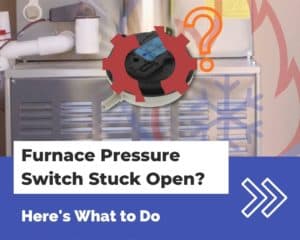When the weather turns cold and you turn on your gas furnace, it’s important to remember the health hazards of furnace exhaust.
Headaches and dizziness are some of the hazards—that’s why gas furnace exhaust should always be vented outside your home.
If gas furnace exhaust gets in your home, it will cause health issues for your home’s occupants.
In this article, I’ll go over what gas furnace exhaust contains, and if it can make you sick. I’ll also discuss what furnace exhaust smells like, and how to keep it out of your home.
Is gas furnace exhaust dangerous?
Yes, gas furnace exhaust is dangerous to your health. Gas furnace exhaust contains carbon monoxide (CO), nitrogen oxides (NOx), and carbon dioxide (CO2), as well as other harmful gases.
Of these gases, carbon monoxide is particularly harmful since it is odorless and poisonous.
If there is a carbon monoxide leak in your home, you’ll have a hard time figuring it out.
That’s why nearly every state requires that carbon monoxide detectors be installed in homes.
Is high-efficiency gas furnace exhaust dangerous?
Yes, high-efficiency gas furnace exhaust is dangerous to your health. Even though high-efficiency furnace exhaust is not hot, it still contains harmful gases and byproducts.
Do not inhale, touch, or otherwise come into contact with exhaust fumes from a high-efficiency gas furnace.
Can gas furnace exhaust make you sick?
Yes, gas furnace exhaust can make you sick. Gas furnace exhaust contains carbon monoxide—an odorless, invisible gas that can cause sickness or death.
Exposure to carbon monoxide can cause carbon monoxide poisoning.
Here are a few symptoms of carbon monoxide poisoning:
- Headaches
- Dizziness
- Nausea
- Confusion
- Shortness of breath
- Blurred vision
- Loss of consciousness
If you are experiencing any of the symptoms of carbon monoxide poisoning, turn off your furnace and call for medical support.
What does gas furnace exhaust contain?
Gas furnace exhaust contains mainly water and carbon dioxide. However, nearly all gas furnaces produce byproducts from gas combustion. Many of the byproducts are pollutants.
The exhaust from a gas furnace contains:
- Nitrogen oxides (NOx)
- Carbon monoxide (CO)
- Carbon dioxide (CO2)
- Methane (CH4)
- Nitrous Oxide (N2O)
- Volatile organic compounds (VOCs)
- Sulfur dioxide (SO2)
- Particulate matter (PM)
Of the pollutants listed above, carbon monoxide is notable because it is odorless, tasteless, invisible, and poisonous.
Inhalation of carbon monoxide can lead to injury or even death. That’s why keeping furnace exhaust out of your home is important.
How to keep furnace exhaust gases out of your home
All gas furnaces should have an exhaust system installed. The purpose of the exhaust system is to vent the harmful exhaust fumes outside of your home.
The exhaust system uses an exhaust pipe to carry the exhaust fumes out of your home. The exhaust pipe usually pokes out of the top or side of a home, where it vents exhaust gases to the atmosphere.’
The exhaust system should be airtight and free of obstructions.
If there is a leak in the exhaust system, then you run the risk of harmful exhaust fumes leaking into your home.
There are a few different safety devices to aid in ensuring that your home is free of exhaust gases.
Perhaps the most important safety device is the carbon monoxide detector.
A carbon monoxide detector is a device that is installed in your home that detects the presence of carbon monoxide. If the detector senses carbon monoxide in the air inside your home, then it will beep loudly—similar to a smoke detector.
If you have a gas furnace installed in your home, then you absolutely need a carbon monoxide detector installed.
Keep in mind that carbon monoxide detectors wear out after a period of time. A typical carbon monoxide detector has a lifespan of around 7 years. So if your carbon monoxide detector is over 7 years old, then it’s time to replace it.
If your carbon monoxide detector starts alarming, then you have an exhaust leak in your home. Turn off your furnace immediately and call your local HVAC professional.
What does furnace exhaust smell like?
Furnace exhaust may smell like rotten eggs, sulfur, or gas. However, it can sometimes be odorless.
That’s why it’s important to always use a carbon monoxide detector in your home. A carbon monoxide detector can detect the presence of furnace exhaust in your home much better than your nose can.
How hot is the exhaust from a furnace?
Older, conventional 80% furnaces typically have exhaust fumes that are around 300-400° F.
Newer high-efficiency furnaces typically have exhaust fumes that are less than 104° C.
Conventional furnaces require a metal exhaust pipe because of the high exhaust fume temperature. If you used a PVC exhaust pipe for a conventional furnace, then the pipe would melt!
High-efficiency furnaces require a plastic (usually PVC) exhaust pipe because of the acidic nature of the furnace exhaust. High-efficiency condensing furnaces produce corrosive water vapor. The corrosive vapor in the exhaust will cause a metal exhaust pipe to rust. That’s why PVC piping is used instead.
But what about melting?
Melting exhaust pipes are not an issue with high-efficiency furnaces since their exhaust temp is only slightly warm.
No matter what kind of furnace you have, it’s not safe to come in contact with furnace exhaust. Do not touch or inhale furnace exhaust, regardless of its temperature.




What are acceptable levels of these gases coming from the exhaust for high efficiency furnaces (96-98% efficient)?
Hi David,
The exhaust from most modern gas furnaces should have carbon monoxide (CO) levels of less than 100 ppm. High-efficiency furnaces sometimes have even lower amounts, around the 50 ppm range, but anything under 100 is generally okay.
If exhaust CO levels climb above 200 ppm, that’s a cause for alarm – your furnace will need adjustment or repair.
If exhaust CO levels climb above 400 ppm, then your furnace will need to be immediately shut down and locked out until its repaired.
Hope this helps,
-Trey
Is it dangerous if the exhaust pipe gets clogged and buried by dense snow? Will exhaust fumes back up into the house.
Hi Liz,
Yes, it is dangerous if the exhaust pipe gets clogged and buried by snow. Your furnace has a pressure switch to detect exhaust blockage and should shut down if its exhaust pipe is blocked. However, it would be best if you still kept your exhaust pipe clear of snow so you won’t run into the problem in the first place.
Hope this helps,
-Trey
We are having high readings of CO2 carbon dioxide in the house. After doing a lot of testing we checked the hvac exhaust with a CO carbon monoxide and CO2 carbon dioxide tester/monitor. There was no CO at all. The CO2 maxed out at 5,000 within 1 minute. Is this normal or within limits?
Hi Sheri,
Yes, it’s normal for CO2 to be in the furnace exhaust.
Do you have lots of people in your home? What is the PPM level of CO2 that you have in your home? People expel carbon dioxide when they breathe. The high concentration of CO2 in your home could be from poor ventilation.
Hope this helps,
-Trey
My outside exhaust pipe is near my back door. In the winter when it’s windy can that exhaust comeback into the house? I open the doors usually daily to air out the house. I can see the Vapor blowing across the doorway when it’s cold & windy!!
Hi Dixie,
It’s possible that it can come back into the house especially if you’re seeing it blowing across the doorway. Without going into too many details, the building code in your area determines the distance that the exhaust pipe can be from doors/windows so you might want to check with a local HVAC company to see if the location is OK and have the pipe relocated if it’s not.
I live in an apartment which is directly above the exhaust pipe from the gas furnace which heats our building. I like to sleep with my bedroom window slightly open. I have been in this apartment for approximately 1-1/2 mths and have been waking up with terrible headaches, sore throats, dizziness and feeling congested. Could this be a sign that the furnace exhaust is getting into my apartment? There is a smoke detector on the ceiling in a short hallway outside my bedroom door, which is supposed to also detect carbon monoxide. Is carbon monoxide detected at ceiling height? Should I be concerned?
It’s possible that the CO is getting into your room. Carbon monoxide is slightly lighter than air, however it tends to disperse evenly throughout a room. Most carbon monoxide detectors are installed at around 5′ from the floor, just like a thermostat, which is at the general height where people reside in a room. Carbon monoxide detectors have a lifespan of 5-7 years, so you should check if yours needs to be replaced.